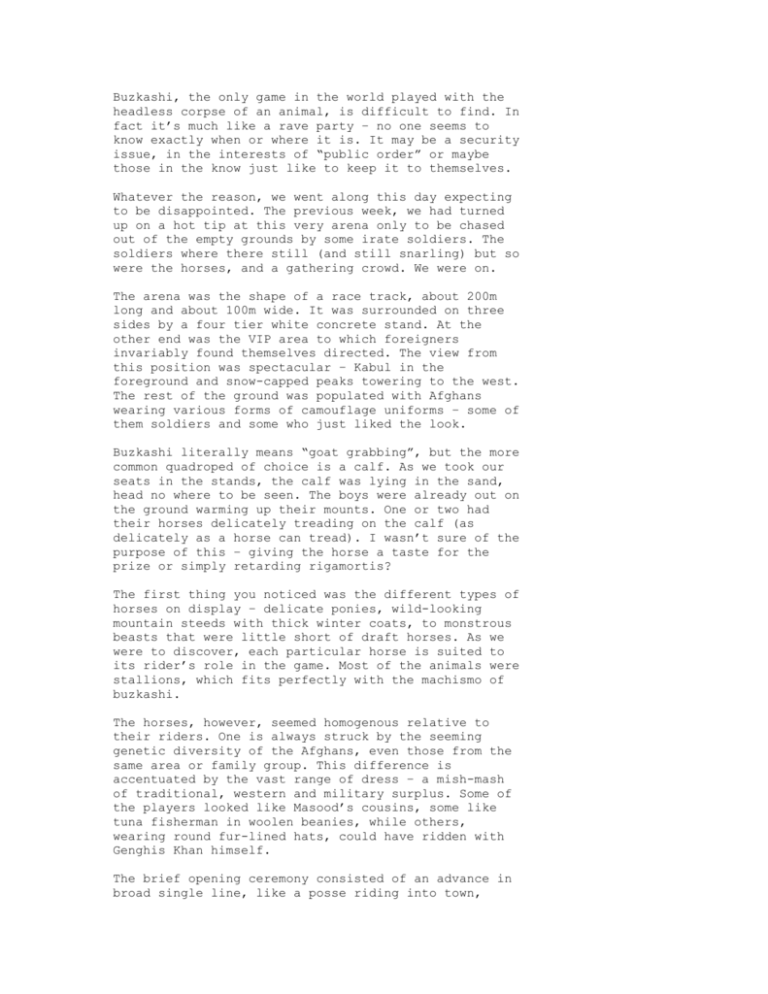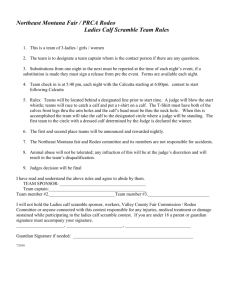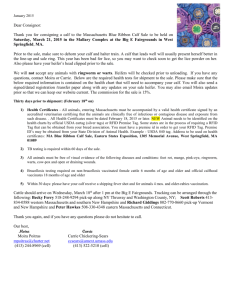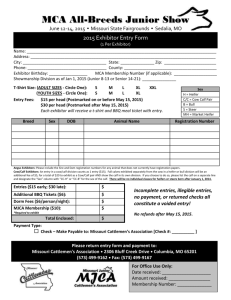to read Matt`s Buzkashi story.
advertisement

Buzkashi, the only game in the world played with the headless corpse of an animal, is difficult to find. In fact it’s much like a rave party – no one seems to know exactly when or where it is. It may be a security issue, in the interests of “public order” or maybe those in the know just like to keep it to themselves. Whatever the reason, we went along this day expecting to be disappointed. The previous week, we had turned up on a hot tip at this very arena only to be chased out of the empty grounds by some irate soldiers. The soldiers where there still (and still snarling) but so were the horses, and a gathering crowd. We were on. The arena was the shape of a race track, about 200m long and about 100m wide. It was surrounded on three sides by a four tier white concrete stand. At the other end was the VIP area to which foreigners invariably found themselves directed. The view from this position was spectacular – Kabul in the foreground and snow-capped peaks towering to the west. The rest of the ground was populated with Afghans wearing various forms of camouflage uniforms – some of them soldiers and some who just liked the look. Buzkashi literally means “goat grabbing”, but the more common quadroped of choice is a calf. As we took our seats in the stands, the calf was lying in the sand, head no where to be seen. The boys were already out on the ground warming up their mounts. One or two had their horses delicately treading on the calf (as delicately as a horse can tread). I wasn’t sure of the purpose of this – giving the horse a taste for the prize or simply retarding rigamortis? The first thing you noticed was the different types of horses on display – delicate ponies, wild-looking mountain steeds with thick winter coats, to monstrous beasts that were little short of draft horses. As we were to discover, each particular horse is suited to its rider’s role in the game. Most of the animals were stallions, which fits perfectly with the machismo of buzkashi. The horses, however, seemed homogenous relative to their riders. One is always struck by the seeming genetic diversity of the Afghans, even those from the same area or family group. This difference is accentuated by the vast range of dress – a mish-mash of traditional, western and military surplus. Some of the players looked like Masood’s cousins, some like tuna fisherman in woolen beanies, while others, wearing round fur-lined hats, could have ridden with Genghis Khan himself. The brief opening ceremony consisted of an advance in broad single line, like a posse riding into town, behind a man carrying the national flag. The boys down from the wilds of Parwan and the Panshir Valley looked decidedly uncomfortable with this artificial pomp. They seemed much happier when the calf hit the ground and the action began. Three or four riders from each side were straight in jostling around the calf, reaching down to grab the corpse off the ground. This act requires a significant amount of dexterity, not to mention bravery - placing your head between a crush of agitated horses. When someone has success, he would break from the pack and using every bit of strength attempt to hoist the calf up. The preferred method of carriage was to hold the calf hooked under the leg and stirrup then leaning to the other side. For some of the smaller men this meant a lean past forty five degrees. The effort often required two hands, so one of his mates would whip the rump of the horse to get it going. Off it would go at very high speed, heading for the marker at the other end of the ground. Sometimes the other team would let the calf-holder go, but other times they would continue to contest, grabbing and reefing at the prize. The most memorable sight on the buzkashi field is two men galloping at full tilt, furiously pulling on the calf’s legs like a giant wishbone. At one stage, such a contest started some distance from us. The apparent winner got away just as they came past our vantage point. However, all he had in his hand was a single leg. With a slightly bemused look, he discarded the limb to the side of the arena. His opponent carried on the game with the rest of the calf. Another quirk of this stage of the game was that play would inexplicably gravitate through a narrow gap in the stands and continue out in the car park. After a few minutes a horseman and a calf would burst back into the arena pursued by the rest of the scrum. This would probably cause some consternation in the box of the Afghanistan Olympic Federation, the supposed custodians of the official version of buzkashi. But a game played until recently over a couple of miles on open plains or in wild mountain valleys is bound to test the limitations of such arbitrary boundaries. Once around the marker, the calf could be brought back to the vicinity of a small circle on the ground. The calf needs to be dropped in this circle to score. This is where the game reached its pinnacle of intensity. The area around the circle became a maelstrom of hooves, whips and cursing men. The confusion was magnified by the fact there was no obvious distinction between the two teams, and by now all twenty or so players had entered the fray. The team in possession tries to force their way in while the defending team blocks, particularly those with the stouter horses. The calf was often obscured from view for minutes at a time. Despite the obvious team dynamic, this is very much the game of the chapandaz (the gun rider). As the renowned Afghanologist Louis Dupree observed “the play continues to characterize the main themes in Afghan culture, best described as close cooperation within a framework of fierce, individual competition”. One of the chapandaz in this game was a level above his fellow players, even to the inexperienced observer. He rode a smallish mount but had an uncanny ability to charge into a pack of twenty horses and emerge with the calf. This was complemented by truly exquisite horsemanship in the open field. As a crude means of cranial protection he wore a leather helmet that looked a parody of a WWII aviator. It gave him the appearance of an escaped lunatic. At one stage the champ fell off his horse with the prize in his hand. He stood up, ran into the pack and handed it up to one of his mates. He then ran out smiling, and got a hearty laugh from the crowd. While I am sure this was a flagrant breach of the rules, the chapandaz must be allowed to take such liberties. Towards the end it was announced that the next scorer would receive $100US, an enormous sum in one of the poorest countries in the world. The intensity of play rose visibly, and the resulting scrum was the most furious of the afternoon. The sun was now low in the sky, and the action was virtually obscured in a luminescent cloud of fine dust. The whips were being used liberally, and from the angry shouts and scowling, it seemed they weren’t only being directed at horses. When it appeared we had reached an equestrian stalemate, it was time for some individual brilliance. The champ burst free from the pack, avoided a loose rider or two and dropped the calf ever so gently in the undefended circle. The crowd loved it. The champ and his mount ambled to the podium, both obviously enjoying the adoration. He received his prize from one of the dignitaries and took the notes around in front of the stands, making sure no one was in doubt who was the chapandaz. It was a fitting end to the afternoon. Apparently Panshir had won but buzkashi seems to be more about the event than the result. The calf was still mainly intact, but had been softened to the point that it wobbled and rolled like a half full wine bladder. The crowd began to file out and after a few pleasantries so did the riders. No horse floats here - the riders and their sweat-coated horses walked out with the rest of the crowd. At the gate, we past the scowling soldiers once more. But now they seemed somehow less threatening. And this time we were going away far from disappointed.







